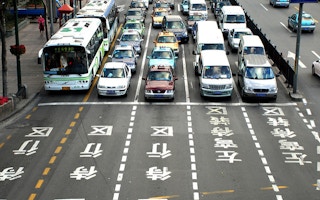With vehicle sales growing rapidly in China – and vehicle-related pollution, too – Chinese policymakers are looking to aggressively shift automakers into producing electric vehicles (EVs) while at the same time encouraging them to improve the fuel efficiency of traditional vehicles.
In January, China launched its toughest fuel economy improvement plan yet. The Stage 4 standards for passenger vehicles require fuel consumption per 100 kilometres to fall rapidly from 6.9 litres to 5 litres between 2016 and 2020, an improvement in fuel economy of 6.2 per cent a year over the period.
But not everyone is happy. The new standard has sparked debate in the automotive sector and concern among think-tanks that the fuel economy of traditional vehicles could stagnate or worsen, despite the market gradually shifts to electric vehicles.
Fuel economy standards
China started mandating fuel economy improvements in 2005. But progress has been slow. Between 2006 and 2015, average fuel consumption per vehicle per 100 kilometres fell from about 8 litres to 7 litres, an annual decline of less than 2 per cent. The new standard is designed to speed things up with a push for twice the progress in half the time.
Meeting the new standard will be a tough task for many manufacturers though, according to Xia Shengzhi, assistant to the secretary general at the China Association of Automobile Manufactures. He said at a conference in October that “overly strict emissions standards and technical requirements will have a huge impact on Chinese passenger vehicle brands.”
“
Produce the right number of electric vehicles and you don’t need to put too much effort into fuel economy for your traditional vehicles, and everything’s rosy.
Liu Minhui, head, electric vehicle department, FAW Group’s R&D centre
Should this just be taken as defensive posturing or can the Chinese government be confident that manufacturers will hit the new target?
Focus on EVs
In 2013, the government encouraged the manufacture of electric vehicles with the introduction of a new method of calculating fuel economy, the Corporate Average Fuel Consumption (CAFC) system. This strongly favoured electric vehicles because each one manufactured was deemed to have zero emissions and be equivalent to five fuel-burning vehicles.
Although this helped to spur the development of China’s electric vehicle market, it also had an unfortunate side effect on fuel economy.
According to a September report published by the Innovation Centre for Energy and Transportation (iCET), a think-tank, if the preferential inclusion of electric vehicles in the CAFC system is ignored, average fuel consumption per 100 kilometres for passenger vehicles nationwide was slightly over 7 litres, meaning it’s still not met the older Stage 3 standard of 6.9 litres per 100 kilometres.
When electric vehicles are included in the CAFC calculations, fuel economy appears much better, at 6.6 litres.
Indeed, the inclusion of electric vehicles in broader fuel economy calculations appears, in some cases, to have worsened fuel economy.
The iCET study analysed fuel consumption changes for ten of China’s top electric vehicle manufacturers and found that when production of electric vehicles reached a certain level the firms effectively gave up on improving the fuel efficiency of their vehicles with internal combustion engines. In some cases, fuel consumption levels even increased.
“Car makers can meet national fuel economy standards simply by making more electric vehicles,” explained Kang Liping, low-carbon transportation project officer for iCET. “Some of the firms producing a high percentage of electric vehicles such as BYD and Geely have even met requirements for 2020 already.”
Liu Minhui, head of the electric vehicle department at FAW Group’s R&D centre, told chinadialogue that in order to keep costs under control and meet fuel consumption standards, many firms would try to find a balance.
“Produce the right number of electric vehicles and you don’t need to put too much effort into fuel economy for your traditional vehicles, and everything’s rosy,” he said. But Liu stressed that this is a short-sighted approach and will not help companies’ long-term development.
This story was originally published by Chinadialogue under a Creative Commons’ License and was republished with permission.

















